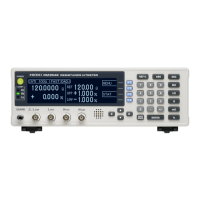9.7 Message Reference
128
(2) Measurement-Related
Set and Query the Resistance Measurement Method
Syntax
Command
[:SENSe:]FUNCtion <RESistance/ LPResistance>
Query
Response
[:SENSe:]FUNCtion?
<RESISTANCE/ LPRESISTANCE>
<RESISTANCE> = Resistance measurement
<LPRESISTANCE> = Low-Power Resistance measurement
Example
FUNC LPR
Selects the Low-Power Resistance measurement.
FUNC?
RESISTANCE
The Resistance measurement has been selected.
Note
[:SENSe:] may be omitted.
Set and Query the Range Setting
Low-Power Resistance Measurement Range
Syntax
Command
[:SENSe:]LPResistance:RANGe <Expected measurement value>
Query
Response
[:SENSe:]LPResistance:RANGe?
<Measurement Range (NR3)>
<Expected measurement value> = 0 to 1200
<Measurement Range (NR3)> = 1000.00E-3/ 10.0000E+0/ 100.000E+0/ 1000.00E+0
Description
Command Enter the expected measurement value. The instrument is set to the most suitable
range for measuring the given numerical value data.
Query Queries the measurement range setting.
Example
LPR:RANG?
10.0000E+0
Low-Power Resistance measurement has been set to the 10 range.
Resistance Measurement Range
Syntax
Command
[:SENSe:]RESistance:RANGe <Expected measurement value>
Query
Response
[:SENSe:]RESistance:RANGe?
<Measurement Range (NR3)>
<Expected measurement value> = 0 to 120E+6
<Measurement Range (NR3)> = 100.000E-3/ 1000.00E-3/ 10.0000E+0/ 100.000E+0/
1000.00E+0/ 10.0000E+3/ 100.000E+3/ 1000.00E+3/ 10.0000E+6/ 100.0000E+6
Description
Command Enter the expected measurement value. The instrument is set to the most suitable
range for measuring the given numerical value data.
Query Queries the measurement range setting.
Example
RES:RANG 95
Sets the Resistance measurement to the 100 range.

